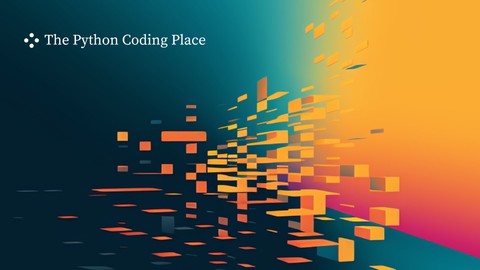| Size: 1.38 GB[/center]
How Functions Function • A Deeper Dive Into Python Functions
Published 4/2024
MP4 | Video: h264, 1920x1080 | Audio: AAC, 44.1 KHz
Language: English
| Duration: 4h 48m
Taking Python functions to the next level
What you'll learn
Master intermediate and advanced Python function topics
Learn about required and optional parameters (default values)
Learn about using positional and keyword arguments
Learn about positional-only and keyword-only arguments
Learn about args and kwargs
Learn about generator functions
Requirements
This is an intermediate course on functions. You should already be familiar with defining functions.
Description
This course covers Python functions at intermediate and advanced levels. Once students have mastered the fundamentals of defining and calling functions, they're ready to start exploring more advanced topics. This course enables students to write more flexible and powerful functions and to be better placed to use functions in the standard library and third-party packages.Functions allow you to package code so you can re-use it flexibly and efficiently whenever and wherever you need to. Understanding all the options available when creating parameters and passing arguments is key to be able to define and use functions effectively.This course covers the following topics:Positional and keyword arguments, and the requirements when mixing argument categories.Optional arguments with default values*args and **kwargsPositional-only and keyword-only arguments using / and *Generator functions using the `yield` keyword--About me, your instructorI've been teaching Python for a decade. Before that, I worked as a physicist and used programming in my research work for over a decade.My focus is on communicating clearly, in a friendly and relaxed manner. I'm the author of the The Python Coding Book (you can ask Google for a "python book" and you'll find this book as one of the first entries) and I have taught Python to individuals and corporations around the world.And I'm approachable. You can ask me questions and I'll always reply, whether here on social media or anywhere else you can find me!
Overview
Section 1: Getting Ready For A Deeper Dive Into Functions
Lecture 1 Get Comfortable and Enjoy The Ride
Lecture 2 Function Names and Function Calls • Returning `None`
Lecture 3 Using Functions as Arguments in Other Functions
Lecture 4 Parameters and Arguments
Section 2: Positional And Keyword Arguments
Lecture 5 What's The Difference Between Positional and Keyword Arguments
Lecture 6 Mixing and Matching Positional and Keyword Arguments
Lecture 7 Changing The Order When Using Keyword Arguments
Lecture 8 Introducing The Contact List Project
Lecture 9 Using Positional and Keyword Arguments • And Using Pretty Print
Section 3: Optional Arguments With Default Values
Lecture 10 Adding Default Values to Make Arguments Optional
Lecture 11 The Order of Parameters With And Without Default Values
Lecture 12 Back to The Contact List Project
Lecture 13 A Side Note About the Order in Dictionaries
Lecture 14 The Mutable Default Value Pitfall
Lecture 15 A Quick Recap and Revisiting `print()`
Section 4: Argh!! What Are Those args And kwargs?
Lecture 16 A Small Detour: Unpacking
Lecture 17 And A Bit More Unpacking
Lecture 18 And A Quick Summary of All The New Terms
Lecture 19 Using Any Number of Optional Positional Arguments • `*args`
Lecture 20 Unmasking `*args`
Lecture 21 Some Rules When Using `*args`
Lecture 22 Using Any Number of Optional Keyword Arguments • `**kwargs`
Lecture 23 And Now, Let's Put `*args` And `**kwargs` Together
Lecture 24 Using `*args` in The Contact List Project • Part 1
Lecture 25 Using `*args` in The Contact List Project • Part 2
Lecture 26 Using `**kwargs` in The Contact List Project
Section 5: Those Rogue Backslashes and Asterisks • Positional-only and Keyword-only Argumen
Lecture 27 The Rogue Backslash In A Function Signature • Positional-only Arguments
Lecture 28 The Rogue Asterisk In A Function Signature • Keyword-only Arguments
Lecture 29 Revisiting `*args`
Lecture 30 Functions With Both `/` and `*`
Section 6: Generator Functions Using The `yield` Keyword
Lecture 31 Replacing `return` With `yield`
Lecture 32 A Bit More on Generator Functions
Lecture 33 Creating Multiple Generators From The Same Generator Function
Section 7: Docstrings, Type Hints, And Some General Best Practices
Lecture 34 Docstrings
Lecture 35 Type Hints • Part 1
Lecture 36 Type Hints • Part 2
Lecture 37 Final Words
This course is for Python learners ready to move to more intermediate topics,This course is ideal for those who are ready to explore Python functions in more detail
https://fikper.com/Leshr0hqYm/How_Functions_Function_•_A_Deeper_Dive_Into_Python_Functions.z01.html
https://fikper.com/KOiHvibwpr/How_Functions_Function_•_A_Deeper_Dive_Into_Python_Functions.z02.html
https://fikper.com/bmIIht7EwM/How_Functions_Function_•_A_Deeper_Dive_Into_Python_Functions.zip.html
https://rapidgator.net/file/a722427e99d7ccdc2ec09021755f9b21/How_Functions_Function_•_A_Deeper_Dive_Into_Python_Functions.z01
https://rapidgator.net/file/f8e0e1fc2e8ee30de706f4dc8e20f855/How_Functions_Function_•_A_Deeper_Dive_Into_Python_Functions.z02
https://rapidgator.net/file/aff4c0b7777bbe0d1baed11abde8d94c/How_Functions_Function_•_A_Deeper_Dive_Into_Python_Functions.zip
Free search engine download: How Functions Function • A Deeper Dive Into Python Functions

 Our Live Cams
Our Live Cams






 Reply With Quote
Reply With Quote